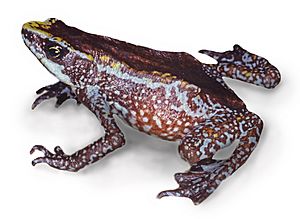Chiriqui harlequin frog facts for kids
Quick facts for kids Chiriqui harlequin frog |
|
|---|---|
 |
|
| Conservation status | |
| Scientific classification |
The Chiriqui harlequin frog (scientific name: Atelopus chiriquiensis) was a type of toad that is now extinct. It was also known as Lewis' stubfoot toad. This frog used to live in the cool, wet forests of the Cordillera de Talamanca mountains. You could find it in parts of Costa Rica and western Panama (in the Chiriquí and Bocas del Toro Province areas).
These frogs lived near streams in lower mountain forests and rainforests. They were found at high elevations, from about 1,400 to 2,500 meters above sea level.
What Did It Look Like?
The Chiriqui harlequin frog was a medium-sized toad. Male frogs were about 2.8 to 3.4 centimeters long from their snout to their rear. Female frogs were a bit bigger, measuring about 3.6 to 4.9 centimeters. Their colors could be very different, and often males and females had different patterns.
These frogs had small, hard-to-see poison glands scattered over their heads and backs. Even though they were small, these glands produced a very strong poison called tetrodotoxin. This poison is a powerful neurotoxin, which means it affects the nervous system. It helped protect the frogs from predators.
Special Features
One interesting thing about the Chiriqui harlequin frog was its hearing. Unlike most animals, this toad did not have a middle ear. Instead, it used other parts of its body to hear sounds. The skin over its lungs, which is part of its body wall, helped transfer sounds to its inner ear. This was a very special way for the frog to hear what was happening around it!
Why Did It Disappear?
The Chiriqui harlequin frog was once very common in the places it lived. However, it has not been seen in Costa Rica since 1996. It is also believed to have disappeared from Panama, with no sightings since the late 1990s. Because of this, scientists now consider the Chiriqui harlequin frog to be extinct.
The main reason for its disappearance was likely a serious frog disease called chytridiomycosis. This disease is caused by a fungus that attacks the skin of amphibians. Other threats also contributed to its decline. These included losing its natural home due to human activities. Also, new types of trout fish were introduced into the streams where the frogs lived. These trout might have eaten the frog's eggs or tadpoles.
The IUCN Red List is a list that tracks the conservation status of species. It now officially lists the Atelopus chiriquiensis as extinct.
See also
 In Spanish: Atelopus chiriquiensis para niños
In Spanish: Atelopus chiriquiensis para niños


